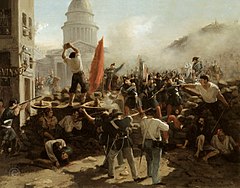
Back Revolusiejaar 1848 Afrikaans 1848er-Revolution ALS الربيع الأوروبي (ثورات 1848) Arabic Revoluciones de 1848 AST 1848-ci il inqilabları Azerbaijani Вясна народаў Byelorussian Вясна народаў BE-X-OLD Революции от 1848 година Bulgarian Revolució de 1848 Catalan شۆڕشەکانی ١٨٤٨ CKB
| Part of the Age of Revolution | |
 Barricade on the rue Soufflot,[1] an 1848 painting by Horace Vernet. The Panthéon is shown in the background. | |
| Date | 12 January 1848 – 4 October 1849 |
|---|---|
| Location | Western, Northern, and Central Europe |
| Also known as | Springtime of Nations, Springtime of the Peoples, Year of Revolution |
| Participants | People of Ireland, France, German Confederation, Hungary, Italian states, Denmark, Moldavia, Wallachia, Poland, and others |
| Outcome | See Events by country or region
|
| Part of a series on |
| Political revolution |
|---|
 |
|
|
The revolutions of 1848, known in some countries as the springtime of the peoples[2] or the springtime of nations, were a series of revolutions throughout Europe over the course of more than one year, from 1848 to 1849. It remains the most widespread revolutionary wave in European history to date.[3]
The revolutions were essentially democratic and liberal in nature, with the aim of removing the old monarchical structures and creating independent nation-states, as envisioned by romantic nationalism. The revolutions spread across Europe after an initial revolution began in Italy in January 1848.[4][5] Over 50 countries were affected, but with no significant coordination or cooperation among their respective revolutionaries. Some of the major contributing factors were widespread dissatisfaction with political leadership, demands for more participation in government and democracy, demands for freedom of the press, other demands made by the working class for economic rights, the upsurge of nationalism,[6] and the European potato failure, which triggered mass starvation, migration, and civil unrest.[7]
The uprisings were led by temporary coalitions of workers and reformers, including figures from the middle and upper classes (the bourgeoisie);[8] however, the coalitions did not hold together for long. Many of the revolutions were quickly suppressed, as tens of thousands of people were killed, and even more were forced into exile. Significant lasting reforms included the abolition of serfdom in Austria and Hungary, the end of absolute monarchy in Denmark, and the introduction of representative democracy in the Netherlands. The revolutions were most important in France, the Netherlands, Italy, the Austrian Empire, and the states of the German Confederation that would make up the German Empire in the late 19th and early 20th centuries. The wave of uprisings ended in October 1849.
- ^ Mike Rapport (2009). 1848: Year of Revolution. Basic Books. p. 201. ISBN 978-0-465-01436-1.
The first deaths came at noon on 23 June.
- ^ Merriman, John, A History of Modern Europe: From the French Revolution to the Present, 1996, p. 715
- ^ "The Revolutions of 1848: A Wave of Anti-Monarchism Sweeps Europe". TheCollector. 12 May 2022. Retrieved 1 March 2024.
- ^ "Revolutions of 1848 | Causes, Summary, & Significance | Britannica". www.britannica.com. 10 November 2023.
- ^ Mack Smith, Denis. The Revolutions of 1848–1849 in Italy. Oxford Academic. Retrieved 19 November 2023.
- ^ R. J. W. Evans and Hartmut Pogge von Strandmann, eds., The Revolutions in Europe 1848–1849 (2000) pp. v, 4
- ^ Ó Gráda, Cormac; Vanhaute, Eric; Paping, Richard (August 2006). The European subsistence crisis of 1845–1850: a comparative perspective. XIV International Economic History Congress of the International Economic History Association, Session 123. Helsinki. Archived from the original on 17 April 2017.
- ^ Edward Shorter, "Middle-class anxiety in the German revolution of 1848." Journal of Social History (1969): 189–215.